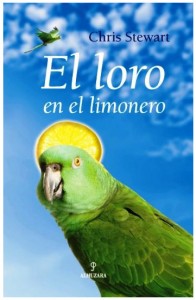What do we mean by “bicho” in Spanish? Chris Stewart´s definition. Posted by Magda on Oct 28, 2012 in Spanish Vocabulary
For me as a teacher, it is very interesting to know what are the difficulties people have when learning Spanish, and what are their impressions about our language and culture. That is probably the reason why I’m enjoying so much the book I’m reading now: “A Parrot in the Pepper Tree”, after reading “Driving over Lemons: An Optimist in Andalusia”, by Chris Stewart.
Both of them relate the author’s personal experiences living in a country state in the south of Spain, “El Valero” in the Alpujarra, with the company of his wife Ana, his daughter Chloe, and a lot of dogs, cats, a flock of sheep, and a misanthropist parrot. You can imagine all the different situations and anecdotes experienced by an English guy, original drummer of Genesis, who spent some years working in a circus, travelled from place to place shearing sheep and writing tourist guides, and who ended up living in a sometimes rustic far off place.
In the chapter I’m reading now, Ethic and anticlericalism, Chris (or Cristobal as he is known by his alpujarreño neighbours) is dealing with two different matters: to prevent badgers from destroying his growing, and to write a letter in Spanish for his daughter’s school bus driver. His thoughts are worth sharing, and maybe you feel motivated to read the whole book after that!
“Aunque quiero pensar que mi vocabulario español ya ha aumentado lo suficiente para ajustarse a la mayor parte de las necesidades de la vida en Las Alpujarras, he descubierto que a cada momento me topo con… bien, con una snare– una trampa.
Los animales, en particular, suponen un mar de incertidumbres (uncertainty). “Comadreja” (weasel), “garduña” (marten), “jineta” (civet cat), “gato clavo” (lynx), “hurón”(ferret), son todos ellos nombres de animales que existen en un ámbito de identidades inciertas, y que a menudo se distinguen solo por el tamaño del agujero (hole) por el que pueden pasar para llevársete las gallinas (hens). Estoy convencido de que existen confusiones parecidas con sus equivalentes en inglés.
Después, si bajas otro escalón en la escala de animales amenazadores (vermin) llegas al todavía más interesante territorio lingüístico de los “bichos (bugs, critters). Pues bien, “bicho” es una de mis palabras españolas favoritas. En general se refiere a una categoría de animales aproximadamente del tamaño de los insectos (como cuando se dice, por ejemplo, “en esta cama hay bichos y me están comiendo vivo”), pero su significado a veces abarca también otros seres pequeños que no son insectos, como por ejemplo los roedores (rodent) y, en circunstancias excepcionales, sus fronteras semánticas pueden incluso abarcar un gato o hasta un perro. A pesar de mi categoría de extranjero y de tener un terriblemente imperfecto dominio del idioma, hasta he conseguido incluir en este campo semántico animales del tamaño de una vaca y un caballo, y añadiendo el sufijo –aco he logrado que la palabra suene a algo temible e incluso amenazador. “¡Vaya bicharraco!”(kind of huge ugly beast), exclamo en algunas ocasiones.
Sin embargo, todo eso son unos inconvenientes lingüísticos de poca importancia comparados con el campo de minas (minefield) que constituye el escribir una carta o una nota.”
(The Parrot in the Pepper Tree, by Chris Stewart)

Build vocabulary, practice pronunciation, and more with Transparent Language Online. Available anytime, anywhere, on any device.





Comments:
apperceptions:
Is a pepper tree the same as a lemon tree in Spain?
Magda:
@apperceptions No, they are two different kind of trees. The Spanish translation uses “lemon tree”, and it is a lemon tree the one described in the book (actually, I´m not sure if a pepper tree can grow in the Alpujarras, because of its climatology), so I don´t know why they used it in the English version.
andreas:
¡Hola Magda!
Ya quiero leer este libro. ¿Pero su versión original es inglesa o española?
Andreas
Magda:
@andreas Yo leí la española, no sabría decirte si se escribió en inglés originalmente, aunque es muy probable por la nacionalidad del autor. ¡Estoy segura de que te divertirá muchísimo!